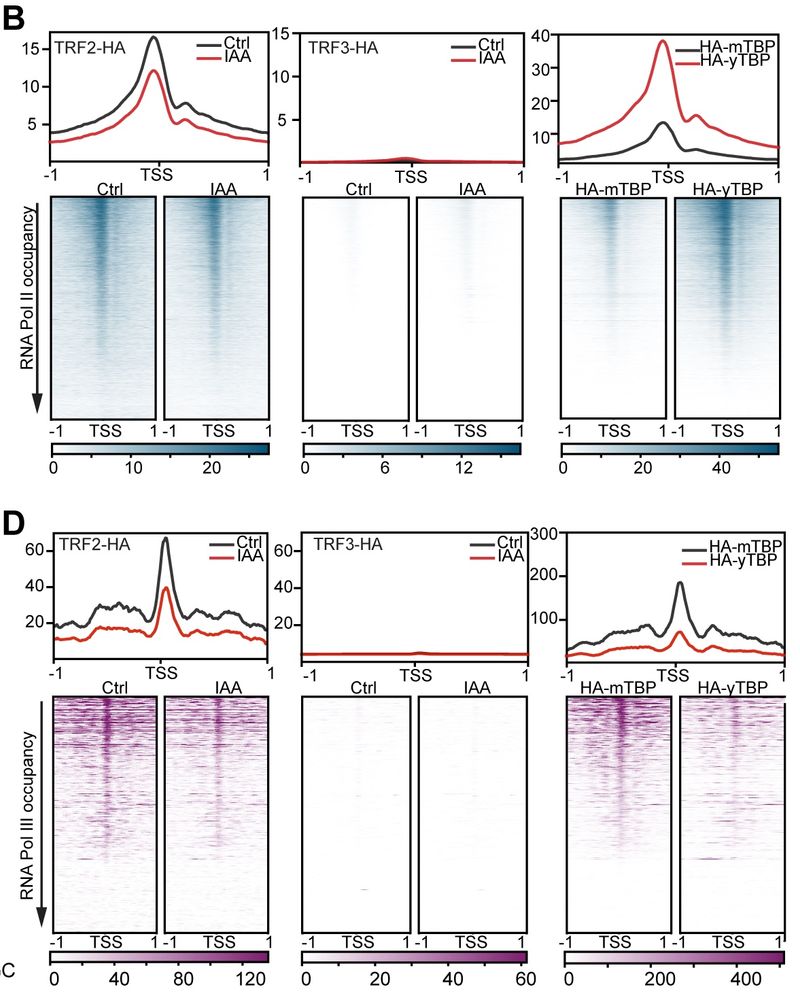





Aided by co-authors Dr. James Kwan, grad student Hazel Cui, and undergrad Jennifer Mitchell.
An amazing team!

Aided by co-authors Dr. James Kwan, grad student Hazel Cui, and undergrad Jennifer Mitchell.
An amazing team!
Prior HS altered Pol3's transcriptional response during subsequent stress.
HSF1 modulates this memory, ensuring rapid adaptation to recurring stress. Without HSF1, Pol III's response was disrupted

Prior HS altered Pol3's transcriptional response during subsequent stress.
HSF1 modulates this memory, ensuring rapid adaptation to recurring stress. Without HSF1, Pol III's response was disrupted
Surprisingly, we found that it has no role in the initial downregulation, but is critical for Pol III recovery during HS. Hsf1-/- mESCs failed to restore Pol III activity by HS60.

Surprisingly, we found that it has no role in the initial downregulation, but is critical for Pol III recovery during HS. Hsf1-/- mESCs failed to restore Pol III activity by HS60.
Confirmed by:
- analyzing published PRO-seq datasets in MEFS
- metabolic labeling using 5'BrU

Confirmed by:
- analyzing published PRO-seq datasets in MEFS
- metabolic labeling using 5'BrU



And these dynamics correlated with their molecular behavior

And these dynamics correlated with their molecular behavior
Turns out, very little, at least under homeostasis. But removing the NTD of mouse TBP leads to exaggerated Pol2 response to heat shock, which is rescued by adding yeast NTD

Turns out, very little, at least under homeostasis. But removing the NTD of mouse TBP leads to exaggerated Pol2 response to heat shock, which is rescued by adding yeast NTD
But no homolog fully rescued RNA Pol III transcription.
The most similar core domain to mouse TBP is the paralog TRF3. Yet, it has the least ability to bind DNA or rescue Pol3
Image

But no homolog fully rescued RNA Pol III transcription.
The most similar core domain to mouse TBP is the paralog TRF3. Yet, it has the least ability to bind DNA or rescue Pol3
Image

Although the homologs share up to 85% similarity in sequence and predicted structure, none of the homologs we examined could rescue cell viability
Image

Although the homologs share up to 85% similarity in sequence and predicted structure, none of the homologs we examined could rescue cell viability
Image
Yet, recent studies have revealed that TBP homologs have diverged throughout evolution much more than previously thought.

Yet, recent studies have revealed that TBP homologs have diverged throughout evolution much more than previously thought.


We found that, during mitosis, TBP binds very strongly to rDNA promoters. Furthermore, restart of rDNA transcription following mitosis is impaired when TBP is depleted.
So... TBP seems to be bookmarking Pol1 genes!

We found that, during mitosis, TBP binds very strongly to rDNA promoters. Furthermore, restart of rDNA transcription following mitosis is impaired when TBP is depleted.
So... TBP seems to be bookmarking Pol1 genes!

So what happens to Pol1 binding? We performed CUT&Tag for TBP and Pol1 with and without TBP depletion (IAA), and find a slight impairment to Pol1 binding in gene bodies.

So what happens to Pol1 binding? We performed CUT&Tag for TBP and Pol1 with and without TBP depletion (IAA), and find a slight impairment to Pol1 binding in gene bodies.
These 2 students joined a brand new lab in 2018, went through the pandemic, and emerged as full-fledged scientists.
The first graduates of the Teves lab... a MAJOR milestone!


These 2 students joined a brand new lab in 2018, went through the pandemic, and emerged as full-fledged scientists.
The first graduates of the Teves lab... a MAJOR milestone!




